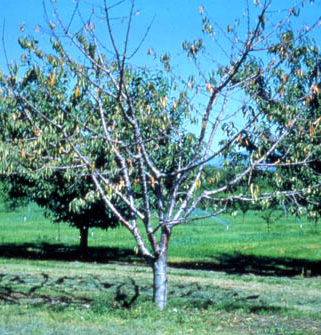Verticillium Wilt of Stone Fruits
General Description
Verticillium wilt is caused by the fungus Verticillium dahliae. Stone fruit are susceptible, particularly apricots, peaches and cherries. Apple and pear are considered to be resistant or immune.
Symptoms:
The first signs of verticillium wilt typically appear in late summer with the yellowing and sudden wilting of leaves. Symptoms sometimes progress from the base of the branch upwards. On cherry, dieback and leaf death occurs on one or more branches, usually on one-year-old wood. The fungus causes brownish discolouration or streaking in the vascular tissue in many woody hosts, but this symptom is not always apparent in cherry. Affected trees become unthrifty and may die, however diseased trees often recover spontaneously. Recovery is more likely when symptoms are mild.
.jpg) |
 |
| Verticillium wilt symptoms in cherry | Advanced symptoms of Verticillium wilt |
Disease Cycle:
This disease is caused by a soil-borne fungus which invades the tree roots and then colonizes and plugs the water conducting system. The fungus can survive in the soil as microsclerotia for many years. It may also overwinter in tree roots.
Verticillium wilt is more common in young orchards, but older cherry and apricot trees may also be affected. High populations of pathogenic nematodes in the soil can increase the amount of damage.
Verticillium dahliae has a wide host range, affecting many trees, fruits, vegetables, ornamentals and weeds. However there are many different sub-groups (vegetative compatibility groups) that are often more pathogenic on some groups of hosts than others. E.g. Verticillium that affects tomatoes and potatoes may be less damaging to trees, but may still be able to infect trees.
Management
Cultural Control
-
Avoid planting sites known to be infested with Verticillium, and sites where susceptible crops have recently been grown.
-
Do not intercrop with other susceptible species such as tomatoes, eggplants, melons or strawberries
-
Prune out dead wood.
-
Do not overwater - the disease is more severe in wet soil.
-
Proper fertilization of the orchard can help trees to recover.
Chemical Control
-
There are no chemical treatments for trees infected with Verticillium wilt.
-
Pre-plant soil fumigation will help to reduce the amount of Verticillium in the soil in known-infested sites. Refer to the article on replant disease for more information on fumigation.
Updated January, 2017
